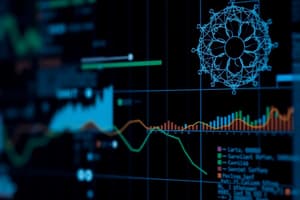Podcast
Questions and Answers
What primary skill is essential for manipulating and analyzing data as a data scientist?
What primary skill is essential for manipulating and analyzing data as a data scientist?
- Programming (correct)
- Machine Learning
- Domain Knowledge
- Critical Thinking
In what type of problem do data scientists predict if a loan applicant will be able to repay a loan?
In what type of problem do data scientists predict if a loan applicant will be able to repay a loan?
- Time Series Analysis
- Binary Classification Problem (correct)
- Multinomial Classification Problem
- Regression Problem
Which of the following tools is commonly used by data scientists for data visualization?
Which of the following tools is commonly used by data scientists for data visualization?
- SQL Server Management Studio
- Python IDE
- Jupyter Notebook
- Tableau (correct)
What is a crucial aspect that data scientists must understand to apply data science effectively in their work?
What is a crucial aspect that data scientists must understand to apply data science effectively in their work?
When evaluating a model's performance in a binary classification problem, what does a probability score indicate?
When evaluating a model's performance in a binary classification problem, what does a probability score indicate?
Which of the following is NOT a fundamental area of skills required for a data scientist?
Which of the following is NOT a fundamental area of skills required for a data scientist?
What may influence the terms of a loan if an applicant is predicted to repay based on a data science model?
What may influence the terms of a loan if an applicant is predicted to repay based on a data science model?
Which skill set enables data scientists to identify patterns and solve complex problems effectively?
Which skill set enables data scientists to identify patterns and solve complex problems effectively?
What is the primary purpose of normalization/scaling in data processing?
What is the primary purpose of normalization/scaling in data processing?
Which method is commonly used for reducing the number of features in a dataset?
Which method is commonly used for reducing the number of features in a dataset?
What is the main objective of exploratory data analysis (EDA)?
What is the main objective of exploratory data analysis (EDA)?
Which of the following techniques is NOT typically associated with feature engineering?
Which of the following techniques is NOT typically associated with feature engineering?
How can aggregation benefit data analysis?
How can aggregation benefit data analysis?
What is the significance of splitting a dataset into training and test sets?
What is the significance of splitting a dataset into training and test sets?
What is the primary goal of regression in predictive modeling?
What is the primary goal of regression in predictive modeling?
Which of the following best describes the concept of joining data?
Which of the following best describes the concept of joining data?
What role does one-hot encoding play in data processing?
What role does one-hot encoding play in data processing?
Which type of classification involves predicting one of two categories?
Which type of classification involves predicting one of two categories?
In a multi-label classification problem, what can an instance potentially be assigned?
In a multi-label classification problem, what can an instance potentially be assigned?
What scenario describes imbalanced classification?
What scenario describes imbalanced classification?
Which of the following is NOT a type of classification mentioned?
Which of the following is NOT a type of classification mentioned?
How does multi-class classification differ from binary classification?
How does multi-class classification differ from binary classification?
What exemplifies a multi-class classification problem?
What exemplifies a multi-class classification problem?
What type of variable does regression often aim to predict?
What type of variable does regression often aim to predict?
What is the primary function of the input layer in a neural network?
What is the primary function of the input layer in a neural network?
How do neural networks adjust the influences of inputs over time?
How do neural networks adjust the influences of inputs over time?
Which layer in a neural network is primarily responsible for the majority of computations?
Which layer in a neural network is primarily responsible for the majority of computations?
What distinguishes a generalist from a specialist in the context of machine learning roles?
What distinguishes a generalist from a specialist in the context of machine learning roles?
What role do the nodes in the input layer of a neural network play?
What role do the nodes in the input layer of a neural network play?
What is the primary focus of a machine learning specialist?
What is the primary focus of a machine learning specialist?
Which of the following layers generates the final outputs in a neural network?
Which of the following layers generates the final outputs in a neural network?
In the context of neural networks, what does backpropagation primarily achieve?
In the context of neural networks, what does backpropagation primarily achieve?
Which of the following tasks can large language models (LLMs) perform?
Which of the following tasks can large language models (LLMs) perform?
What does prompt engineering primarily focus on?
What does prompt engineering primarily focus on?
Which parameter is NOT typically adjusted when interfacing with LLMs?
Which parameter is NOT typically adjusted when interfacing with LLMs?
What skill does prompt engineering help to improve?
What skill does prompt engineering help to improve?
How do temperature settings impact the output of an LLM?
How do temperature settings impact the output of an LLM?
Which of the following is an example of a text generation application of LLMs?
Which of the following is an example of a text generation application of LLMs?
What type of tasks are suited for LLMs when it comes to understanding language?
What type of tasks are suited for LLMs when it comes to understanding language?
Which setting would you adjust to control how diverse the model's responses are?
Which setting would you adjust to control how diverse the model's responses are?
Flashcards are hidden until you start studying
Study Notes
Data Scientist
- A data scientist is a professional who uses scientific methods, algorithms, and systems to extract insights and knowledge from structured and unstructured data.
- Skills of a data scientist include programming, statistics and mathematics, machine learning, data visualization, domain knowledge, critical thinking.
- Programming: Proficiency in languages like Python, R, and SQL for data manipulation and analysis.
- Statistics and Mathematics: A strong foundation in statistical methods, probability, and linear algebra.
- Machine learning: Knowledge of algorithms, model development, and evaluation techniques.
- Data Visualization: Ability to create visualizations using tools like Matplotlib, Seaborn, Tableau, or Power BI to communicate insights.
- Domain Knowledge: Understanding the specific industry or business context to apply data science effectively.
- Critical Thinking: Strong analytical skills to identify patterns, solve complex problems, and make data-driven decisions.
Problems that Data Scientists Solve
- Classification Problems: Predicting a discrete target variable.
- Examples include spam filtering, handwriting recognition, and image classification.
- Binary Classification: Classifying into two mutually exclusive categories.
- Examples include repaying a loan (yes/no), spam or not spam.
- Multi-Class Classification: Classifying into at least two mutually exclusive categories.
- Example: Classifying images as cats, dogs, or horses.
- Multi-label Classification: Assigning one or more classes to an instance.
- Example: A news article could be categorized as technology, health, and travel.
- Imbalanced Classification: The number of examples is unevenly distributed in each class.
- Example: Detecting fraud, where fraudulent cases are significantly less common than legitimate ones.
Exploratory Data Analysis (EDA)
- An approach to analyzing data sets to summarize their main characteristics and uncover patterns, relationships, and anomalies.
- An essential step in the data analysis process that helps understand the data before applying more complex statistical or machine learning techniques.
Regression
- A type of analysis to predict values of continuous dependent variables using independent explanatory variables.
- Models linear relationships between dependent and independent variables.
Neural Networks
- Inspired by biological neural networks in the human brain.
- Powerful computational models that leverage interconnected layers of artificial neurons (nodes).
- Nodes receive input data, process it with a set of predefined rules, and pass the result to the next layer.
- Three Essential Layers:
- Input Layer: Receives raw data attributes
- Hidden Layers: Perform most of the computations
- Output Layer: Generates the final outputs.
Large Language Models (LLMs)
- Language models capable of performing tasks such as:
- Text to text generation
- Text to image and image to text generations
- Code generations
- Key breakthrough: attention mechanisms allowing the model to focus on the meaning of the words being processed.
Prompt Engineering
- A discipline for developing and optimizing prompts to efficiently use language models (LMs) for various applications and research topics.
- Skill set involving:
- Designing and developing prompts
- Interacting and developing with LLMs
- Understanding capabilities of LLMs.
- Common LLM Settings:
- Temperature: Influences randomness in output
- Top P: Controls diversity of output
- Max Length: Sets maximum output length
- Stop Sequences: Indicates when to stop generating text
- Frequency Penalty: Penalizes repeated words
- Presence Penalty: Penalizes overused words.
Studying That Suits You
Use AI to generate personalized quizzes and flashcards to suit your learning preferences.




